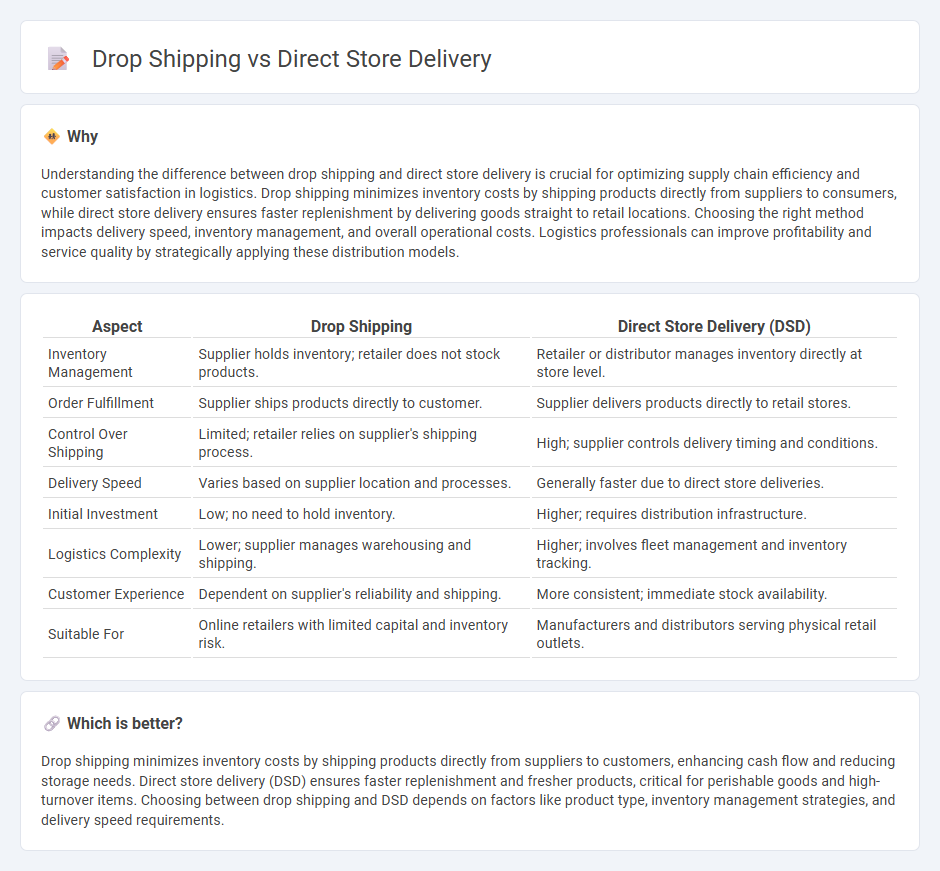
Drop shipping allows retailers to sell products without holding inventory, as suppliers ship items directly to customers, reducing overhead and warehousing costs. Direct store delivery (DSD) involves manufacturers delivering products straight to retail stores, ensuring faster replenishment and better control over shelf stocking. Explore the key differences between drop shipping and DSD to optimize your supply chain strategy.
Why it is important
Understanding the difference between drop shipping and direct store delivery is crucial for optimizing supply chain efficiency and customer satisfaction in logistics. Drop shipping minimizes inventory costs by shipping products directly from suppliers to consumers, while direct store delivery ensures faster replenishment by delivering goods straight to retail locations. Choosing the right method impacts delivery speed, inventory management, and overall operational costs. Logistics professionals can improve profitability and service quality by strategically applying these distribution models.
Comparison Table
| Aspect | Drop Shipping | Direct Store Delivery (DSD) |
|---|---|---|
| Inventory Management | Supplier holds inventory; retailer does not stock products. | Retailer or distributor manages inventory directly at store level. |
| Order Fulfillment | Supplier ships products directly to customer. | Supplier delivers products directly to retail stores. |
| Control Over Shipping | Limited; retailer relies on supplier's shipping process. | High; supplier controls delivery timing and conditions. |
| Delivery Speed | Varies based on supplier location and processes. | Generally faster due to direct store deliveries. |
| Initial Investment | Low; no need to hold inventory. | Higher; requires distribution infrastructure. |
| Logistics Complexity | Lower; supplier manages warehousing and shipping. | Higher; involves fleet management and inventory tracking. |
| Customer Experience | Dependent on supplier's reliability and shipping. | More consistent; immediate stock availability. |
| Suitable For | Online retailers with limited capital and inventory risk. | Manufacturers and distributors serving physical retail outlets. |
Which is better?
Drop shipping minimizes inventory costs by shipping products directly from suppliers to customers, enhancing cash flow and reducing storage needs. Direct store delivery (DSD) ensures faster replenishment and fresher products, critical for perishable goods and high-turnover items. Choosing between drop shipping and DSD depends on factors like product type, inventory management strategies, and delivery speed requirements.
Connection
Drop shipping and direct store delivery (DSD) both streamline supply chains by minimizing inventory holding and accelerating product flow from suppliers to end customers. Drop shipping eliminates intermediary storage by shipping products directly from suppliers to consumers, while DSD bypasses warehouses by delivering goods straight to retail shelves. These models optimize logistics by reducing handling costs, improving delivery speed, and enhancing inventory management efficiency.
Key Terms
Inventory Ownership
Direct store delivery (DSD) ensures retailers maintain ownership and immediate control over inventory, allowing for faster replenishment and reduced stockouts. Drop shipping transfers inventory ownership and fulfillment responsibilities to the supplier, minimizing retailer's upfront investment but potentially complicating inventory tracking and delivery speed. Explore the advantages and challenges of each fulfillment model to determine the best fit for your supply chain needs.
Delivery Route
Direct store delivery (DSD) involves suppliers delivering products directly to retail stores, optimizing delivery routes for faster restocking and inventory management. Drop shipping bypasses physical stores entirely, shipping products directly from manufacturers or wholesalers to customers, which eliminates the need for physical route planning but relies heavily on efficient courier networks. Explore more to understand which delivery strategy best fits your supply chain and customer service goals.
Order Fulfillment
Direct store delivery (DSD) involves suppliers delivering products directly to retail stores, ensuring faster restocking and better inventory control, while drop shipping relies on suppliers shipping orders directly to customers without holding inventory, reducing retailer overhead. Order fulfillment in DSD allows retailers to maintain product quality through immediate store placement, whereas drop shipping prioritizes efficiency by bypassing physical warehousing. Explore detailed comparisons to optimize your order fulfillment strategy.
Source and External Links
What Is Direct-Store Delivery (DSD)? What Are Its Benefits? - Direct-Store Delivery (DSD) is a distribution model where manufacturers deliver products directly to retail stores, bypassing traditional distribution centers, enhancing product freshness and customer satisfaction.
What Is Direct Store Delivery? - Direct Store Delivery (DSD) is a method where products are delivered directly from the manufacturer to the retail store, ideal for high-demand products and offering greater control over retail shelf space.
What is Direct Store Delivery? - Direct-Store Delivery (DSD) involves shipping products directly from suppliers to retail stores, minimizing labor costs and improving efficiency by reducing supply chain touchpoints.
 dowidth.com
dowidth.com